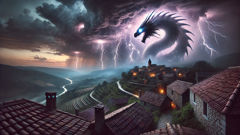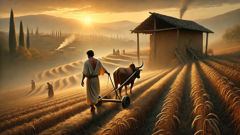Introduction
On wind-swept ridges above the Sava and Drina rivers, among tile roofs and the low stone walls of small Serbian villages, people once named the weather as carefully as they named their children. They listened for the first crack of thunder in spring and watched the shape of clouds as though those shapes were maps. From those songs and whispers came tales of the Hala: a fierce, female storm spirit who rides the squall and throws hailstones like pebbles from a sling. She is a dragon and a snake, an old woman of the clouds, a force that overturns fields and spares what she favors. Farmers would trace salt into the furrows and call out, not to some distant god, but to the Hala herself; shepherds claimed she favored high pastures, while children dared each other to run into the rain to test her temper. In some places she is feared as ruin incarnate—hail that scours a wheat field in an hour—while elsewhere she is respected as a wild, necessary agent of weather that has its own logic and mercy. This retelling stitches together fragments from oral history, archival echoes, and the kind of intimate memory that lingers in households whose livelihoods rose and fell with a season. It seeks to resurrect the Hala not merely as a cataloged monster but as an elemental presence shaped by landscape, livelihood, and the human need to make sense of sudden ruin. In the pages that follow you will travel to ridgelines and market squares, to hearths where charms were braided, and to altars of wind and metal where people bartered with thunder. You will hear the Hala’s roar refracted through generations: as a warning, an explanation, a prayer, and, sometimes, an artful excuse for the caprices of weather.
Origins, Shape-shifting, and the Many Faces of the Hala
The Hala's lineage breathes from the same ancient weather-lore that animated much of the Balkans. In the oldest songs—some collected by traveling ethnographers in the 19th century, others still spoken under breath by elder women—the Hala appears at the intersection of Slavic myth, pastoral practice, and pre-Christian weather lore that refused to surrender its hold on everyday language.

She arrives in stories as a dragon with scales like hammered tin, an enormous serpent that uncoils from a black cloud, a crone with wind-torn hair, and even as a towering woman whose garments are woven from the storm itself. These shapes are not contradictory within the folk imagination. They are variations on a vital force: something that can brood in the high air, stretch its back across a valley like a ridge, or descend into the fields with the focused intent of a hungry eye. In many tellings, the Hala is especially female—a gendering that matters. As a woman she holds associations with domestic weather practices: she protects and threatens in ways that reflect the household economy of rural Serbia, where women historically timed sowing, tended orchards, and guarded granaries. The storm that knocks branches onto roofs and scatters grain from drying racks is not merely a meteorological event; it is a kin to household fortune being tested.
Oral testimonies describe how the Hala makes herself known. Before the first severe hail, there is often a particular hush: birds fly lower, dogs whine at the door, and an odd metallic tang enters the air—people call it the smell of ozone, though they name it as a presence. Then the clouds gather as if pulled by threads. Some claim to have seen a coiling silhouette against lightning, a long neck tipped with an opening like a mouth, or a flash of bright scales glinting like coins. Farmers tell of hearing a hiss, as if wind passes through a reed. In certain valleys the Hala is believed to travel with a retinue of lesser spirits—small stormlings that dart like swallows ahead of the main body, stirring branches toward particular fields. These attendants are often blamed when a single orchard is hit by hail while the next field remains untouched. Such specificity shows how people made sense of selective ruin.
Ancient etymologies for the Hala's name are tangled. Some linguists trace it to Proto-Slavic roots tied to brightness and fury, others to older Balkan tongues where similar-sounding words meant swirl or twisting wind. Regional dialects shift the vowel and consonants; in one village she may be 'Halja' or 'Halka'—each inflection carrying local color. In folk variants she crosses boundaries easily: the Hala is sometimes conflated with the Morana of death and winter, who also carries a scything quality although Morana belongs to the seasonal cycle rather than the immediate violence of hail. In other places the Hala blends with dragon-sagas, where the dragon is not a hoarder of treasure but a meteorological agent. This fluidity is crucial to understanding the Hala: she is a mythic figure that slinks along the edges of several archetypes—dragon, witch, weather spirit—so that different storytellers can emphasize whatever angle best helps them explain a sudden loss.
The agricultural rhythm made the Hala practical as well as symbolic. Hail could mean ruin in a single storm: a couple of hours of violent pellets could strip fruit from trees, dent livestock hides, bruise grain heads, and in a village without insurance or market buffers, ruin a season's income. Consequently, the rituals to guard against her were not mere superstition. They were techniques of communal resilience. Farmers and householders developed rites that were at once psychological—giving a sense of agency—and physically useful—like driving clay stakes into the ground to divert wind or covering grapes with straw to prevent bruising. The Hala's narrative also worked as a cautionary tale: children were warned not to venture into open fields when the sky looked wrong, and unmarried women had songs that included references to wind and the Hala’s jealous temper. In many tales, her anger is personal—she punishes pride or neglect—while in others she is capricious, indifferent to human morals. Both strands survived because they served different social functions: one to teach prudence, the other to soothe the inexplicable.
Art and material culture absorb these images. Woodcuts, embroidery motifs, and painted panels sometimes show a long sinuous body wrapped around a cottage, or a dragon's head spewing small pellets that are clearly depicted as hail. The choice of a dragon is no accident. Across many Eurasian cultures, serpentine creatures patrol thresholds—between sky and earth, life and ruin—and the dragon serves as a powerful visual shorthand. In Serbia, the Hala's dragon-figure allows artists and makers to compress complex ideas about weather, fate, and community into an arresting form. Even today, local painters who work from oral accounts incorporate the Hala into icons that hang in private homes, not as saints but as reminders of weather's sovereignty.
These origins and forms are not static museum pieces. They are living, shifting narratives that have adapted to changing climates and economies. While scientists now explain hail formation with convective cells and temperature gradients, the Hala remains useful to a people who still measure lives in harvests. Her figure has broadened too: in modern literature, film, and visual art she can represent ecological fury, a metaphor for climate change that crushes harvests in new and unpredictable ways. Yet even when she becomes a symbol on a poster or a motif in a gallery, the Hala's roots pull her back into the soil—she is remembered most vividly where the land is tilled and the risk of hail remains an immediate concern.
Ultimately, the Hala's multiplicity—dragon, crone, serpent, storm—reveals how human communities animate natural phenomena to preserve meaning. She is at once a monster and a neighbor: dangerous, demanding, necessary. When weather rearranged hopes and incomes, people needed an explanation and a strategy; they gave the tempest a name and a face, and in doing so made the Hala both a creature of myth and a participant in the measurable dramas of everyday life.
Rituals, Remedies, and the Hala in Everyday Life
If the Hala’s form is rich with symbolism, the practices surrounding her are equally textured. In villages across Serbia, a repertoire of rituals developed with the express function of keeping hail at bay or mitigating its damage. These practices range from the purely symbolic—songs, processionals, and charms—to the immediately practical—covering grapevines with straw, moving livestock into sheltered barns, and sounding bells. Both logic and tradition inform the choices.

One common village practice involved the 'zvončari' or bell-ringers—a tradition preserved in parts of the Balkans where masked figures beat drums and bells to ward off evil and change weather's course. When a storm approached, some communities believed that loud, rhythmic noise could confuse or frighten the Hala, causing her to pass by or to spend her fury elsewhere. The sound of bells and rattles is a cross-cultural weather remedy; the Hala narratives folded it into local cosmology. In other places, people lit fires along field edges, thinking the smoke would redirect the storm's path or at least soften hail. Fire, like many rituals, operated on two levels: it was a practical attempt to alter microclimates and a symbolic assertion of human agency against the chaotic forces above.
Household remedies were more intimate and often performed by women who managed seed and storage. Salt was used in many agricultural rites—spread in corners of barns or on thresholds to create a line the Hala would not cross. Salt is a purifying substance in many folk practices, and in the case of the Hala it also stood as a literal protection for seeds and stored grain. In some mountainous regions, people tied small pieces of iron or hammered coins to belt lines and gates, believing metal repelled storm spirits. The connection between metal and lightning is obvious; the belief that metal could disturb a supernatural being rooted in the sky made sense to people who observed sparks and saw metal as a bridge between earth and the heavens.
Songs and spoken warnings also shaped behavior. A farmer’s granddaughter might sing a lullaby that included lines aimed at coaxing the Hala away: a bargaining song promising a share of the harvest if the storm spared certain rows. These bargaining rituals were less about literal exchange and more about narrative psychology—they framed the relationship between human and weather as negotiable rather than purely submissive. The promise itself functions as a ritualized practice of restraint: whether or not the Hala understood such bargains, the act of making them produced a sense of control and decreased fatalism.
When a field was struck by hail, the community’s response involved both mourning and repair. Neighbors gathered to assess the damage, share labor, and reallocate resources like seed and fodder. Stories told of communal kitchens that cooked extra food for families who lost their harvest; the material solidarity was as important as the liturgy of charms. In this way the Hala's visits catalyzed social practices that reinforced cohesion. The myth and the remedy were entwined: where the Hala's strike could otherwise isolate victims, folk response created networks of mutual aid that softened the blow.
Priests and clerics also engaged with Hala lore. In some parishes, priests incorporated prayers into processions asking for protection from storms, recasting pagan forms into Christianized liturgies. Icons of saints associated with weather, such as St. Elijah (a saint with thunder associations in the Balkans), coexisted with local charms; villagers could combine the two without seeing contradiction. In other instances, church authorities denounced certain charms as superstition, yet the charms persisted in private. This coexistence shows the Hala's role as a liminal figure—she belongs to a space both inside and outside formal religion, a sign that popular practice often blends belief systems to meet very pragmatic needs.
Modernity has altered but not erased these practices. Meteorological forecasting has diminished the predictive dependency on myth, but for many rural communities the Hala remains a useful cultural shorthand. When hail unexpectedly destroys a crop, the language of the Hala provides a communal script for grief and explanation. Contemporary artists and writers use her commonly as a metaphor for sudden ecological violence or as a figure representing the unpredictability of climate. Environmental activists sometimes repurpose the Hala's fury to draw attention to the human-made changes that intensify weather extremes. Meanwhile, local festivals occasionally stage the Hala—through mask, costume, or dramatized re-enactment—turning fear into performative memory and making the narrative a visible part of cultural tourism.
There are also darker tales where the Hala is personalized as retribution. Some narratives punish hubris: a man who belittles a widow's caution finds his field singled out; a lord who orders drainage recklessly awakens the Hala's wrath. These moralized stories function as governance by folklore: they incentivize frugality, respect for the vulnerable, and prudent land management. But there is no single moral. Many stories leave the Hala morally ambiguous: she cannot be fully enlisted as a guardian nor wholly demonized. This ambiguity makes her durable as a figure because moral absolutes rarely capture the texture of weather's effects.
The Hala also appears in children’s games and seasonal customs. Children know the Hala's tales not as lectures but as stories with dramatic set pieces—hurryings into cellars, clever bargains with the storm, disguises that fool the dragon. These playful retellings keep the memory alive and transmit practical wisdom: know how to shelter quickly, respect the sky's moods, and look to neighbors in times of loss. Such informal education proved vital for communities where a single weather event could determine survival.
Even in urban contexts, the Hala's image endures. Artists in Belgrade and Novi Sad have painted murals where a dragon-like Hala threads between apartment blocks, juxtaposing ancient weather-lore with contemporary life. Photographers document older women recalling pre-war harvests, and poets write elegies to orchards lost to hail. The Hala thus migrates from the field to gallery and page, preserving her status as both an historical figure and a living emblem of human-weather relations.
By studying the rituals and lived practices centered around the Hala, we see an essential truth about folklore: it functions as a technology of adaptation. Mythology supplies not only stories but also practices—distributed knowledge born of repeated encounters with risk. The Hala's tale is therefore not merely a curiosity; it is a record of how communities coped with unpredictability, negotiated ruin, and built mutual aid that might, in aggregate, determine whether a family endured a harsh season or sank under it. In that sense she remains, even now, a teacher of resilience.
Conclusion
The Hala endures because she answers a particular human need: to make a natural catastrophe comprehensible and, where possible, negotiable. Whether imagined as dragon, serpent, or storm-woman, she mediates between sky and field, fortune and labor. Her stories preserve memory—methods of protection, songs that coax a storm away, shared labor after a hit—and they preserve ethics: respect for weather, care for neighbors, and humility before forces that cannot be fully tamed. As climate patterns shift and extreme weather becomes more frequent in many places, the Hala's old stories gain new relevance. They remind us that communities have long adapted through knowledge, ritual, and mutual aid; they also remind us of the deep human impulse to name the forces that shape our lives. In that naming is power: a way to tell a story, to warn a child, to warn a neighbor, and to stand together when the hail comes.













